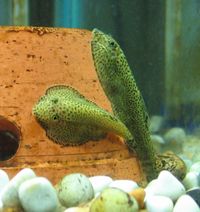Fish Guide
Cypriniformes
|
From Wikipedia the free encyclopedia, by MultiMedia |
| Cypriniformes | ||||||||
|---|---|---|---|---|---|---|---|---|

Beaufortia kweichowensis
|
||||||||
| Scientific classification | ||||||||
|
||||||||
|
Suborder Cobitoidea Balitoridae (hillstream loaches) Catostomidae (suckers) Cobitidae (loaches) Gyrinocheilidae (algae eaters) Suborder Cyprinoidea Cyprinidae (carps and minnows) |
The Cypriniformes are an order of ray-finned fish, including the minnows and some related families. Historically these included all the forms now placed in the superorder Ostariophysi except the catfish, which were placed in the order Siluriformes. However, so defined the Cypriniformes are paraphyletic, and the orders Gonorhynchiformes, Characiformes (characins and allies), and Gymnotiformes (knifefishes and electric eels) have been separated out.
Aside from the features they share with the rest of the Ostariophysi, of which the Weberian apparatus is the most notable, the Cypriniformes are distinguished by having a single dorsal fin (most of the others have a second, fleshy adipose fin) and by having teeth in the throat rather than the mouth, called pharyngeal teeth.
The most notable family placed here is the Cyprinidae, the carps and minnows. This is the largest family of fish, with members found on all continents except Australia. A few species are found in brackish water, but almost all are found exclusively in freshwater. The other Cypriniformes include the Catostomidae, or suckers, and the Cobitidae, or loaches. The "Bala shark" (Balantiocheilus melanopterus) commonly found in home aquariums, is also a member.
References
- "Cypriniformes." FishBase. ed. Froese, R. and D. Pauly (03/2004), Cypriniformes
- "Cypriniformes." ITIS Standard Report. (Integrated Taxonomic Information System: National Museum of Natural History, Washington, D.C., 2004-04-28). ITIS 162846
Fish Guide, made by MultiMedia | Free content and software
This guide is licensed under the GNU Free Documentation License. It uses material from the Wikipedia.